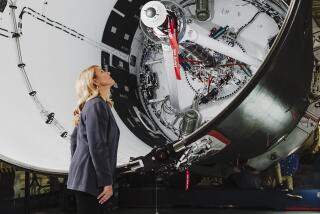A NEW ROCKWELL? : Beall Credited With Firm’s Transformation
- Share via
Donald R. Beall always was considered a young man in a hurry as he climbed the corporate ladder to take the reins of Rockwell International Corp. and steer it in a new direction.
His energy and his ambition are reflected in the overhaul of the company from an aerospace and defense firm to a conglomerate of peacetime ventures that make a variety of unrelated products--from facsimile machines to truck axles--that typically are leaders in their fields.
But mostly, it has been Beall’s ability to maneuver a hulking, slow-footed giant into a post-Cold War power that has won admiration for him and Rockwell.
“His greatest contribution as chief executive of Rockwell has been his determination--almost obsession--with changing the direction of the company,” said his friend and neighbor Richard Bertea, a retired Parker-Hannifin Corp. executive.
Beall was unavailable for comment Wednesday.
But his tenure as a top Rockwell executive has not been free of controversy.
Despite his success in replacing Rockwell’s lost defense income with sales from commercial lines, the company nonetheless has slashed its Southern California work force by 50% since 1989, to 17,200 workers from 34,500. After one wave of job cuts in 1992, several laid-off employees stood at the company’s annual meeting and blasted Beall and other managers for visiting hardships on workers in order to improve the company’s profit.
In the late 1980s, Rockwell’s operation of the Rocky Flats nuclear-weapons plant near Denver--which developed into one of the nation’s most notorious environmental problems--also harmed the company’s reputation and bank account.
The plant was shut down in 1989 after federal agents raided the complex and found the company had allowed toxic waste to leak from outdoor containers. Rockwell eventually pleaded guilty and paid $18.5 million in fines, and another company later took over the plant’s operation.
More recently, Rockwell’s Rocketdyne unit has been the subject of a criminal investigation after a 1994 chemical blast that killed two scientists at the firm’s Santa Susana Field Lab.
Sources told The Times last month that federal prosecutors were preparing to file felony charges against Rockwell, apparently for violations of work-safety and environmental laws, but that the company was negotiating to settle the charges without a trial by admitting guilt and paying fines for the explosion.
Rockwell declined to comment on the reported settlement talks except to say it is continuing to cooperate with the government’s investigation.
Despite those problems, Rockwell has remained consistently profitable. And Beall’s willingness to consider peddling Rockwell’s once-proud aerospace and defense units doesn’t surprise his friends and associates.
Beall, 57, takes a global view of the future and the decisions he makes, said home builder Gary L. Brinderson, who worked with Beall on various projects for the local chapter of the Young Presidents Organization.
“He’s always concerned about the whole environment he’s operating in, the ramifications on life, on business--the big picture,” Brinderson said.
Beall is “very nimble” in making business decisions as well as in playing sports, said Forest E. Olson, a former chief executive of Coldwell Banker Residential brokerage. “He plays hard and works hard, and is a tremendous contributor to good causes.”
Beall’s “brilliant transformation of Rockwell is probably the unsung major success story in American business today,” said Larry Higby, president of Unocal’s 76 Products Co. division in Costa Mesa.
*
Yet despite his success in changing Rockwell, Beall has struggled to change the company’s image as an aerospace powerhouse. The company has waged an intensive public-relations campaign to tout its altered state, and even though the changes have been occurring for years, Rockwell’s new annual report is titled “It’s Time to Change Your Perception of Rockwell.”
Beall was a metallurgical engineering student at San Jose State University when he switched to the business side. He earned his master’s degree in business administration at the University of Pittsburgh.
He joined Ford Motor Co. in what became Ford Aerospace & Communications and quickly rose to controller in that division. He moved to Rockwell’s Collins Radio unit in 1968 and rose at breakneck speed to become Rockwell’s president in 1979 at age 40. Nine years later, he became chairman and chief executive.
(BEGIN TEXT OF INFOBOX / INFOGRAPHIC)
On the Block
Here are the divisions that Rockwell International is considering selling:
Rocketdyne
Headquarters: Canoga Park
Employees: 5,200
Products: Rocket engines, including main engines for space shuttle; electric power system for space station; laser weaponry; propulsion system prototypes for X-33, a potential space shuttle successor
Space Systems
Headquarters: Downey
Employees: 7,100
Products: Space shuttle orbiters, Navstar Global Positioning Satellites, X-33 vehicle prototypes, anti-missile defense systems for Air Force and Army
Autonetics and Missile Systems
Headquarters: Anaheim
Employees: 3,200 employees
Products: Guidance and control equipment for missiles and ships, global-position-finding equipment, transportation management systems
Communications Systems
Headquarters: Richardson, Texas
Employees: 1,000
Products: Satellite communications systems
North American Aircraft
Headquarters: Seal Beach
Employees: 2,500
Products: B-1 bomber, parts for Boeing jetliners, advanced aircraft
Sources: Rockwell International, Standard & Poor’s Register. Researched by JANICE L. JONES / Los Angeles Times
More to Read
Inside the business of entertainment
The Wide Shot brings you news, analysis and insights on everything from streaming wars to production — and what it all means for the future.
You may occasionally receive promotional content from the Los Angeles Times.










